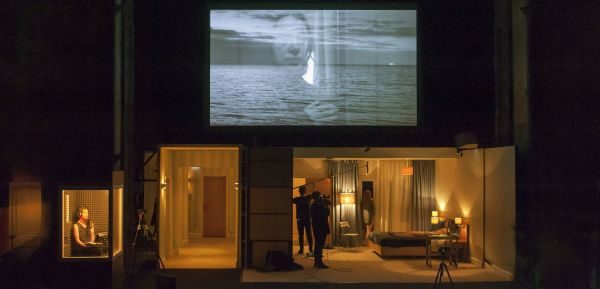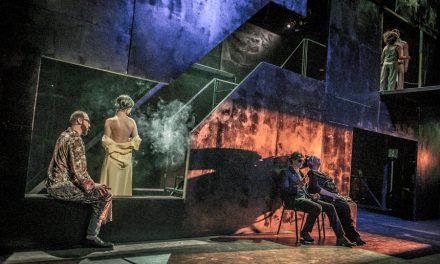As its title suggests, La Maladie De La Mort is not exactly an uplifting piece of theatre. In Marguerite Duras’ original prose version set in a hotel room by the sea somewhere, the main protagonist is a man who pays a woman for sex over a number of days in order to find out what love is. In this adaptation, which sees director Katie Mitchell collaborating with writer Alice Birch for the third time in close succession, the main protagonist, unsurprisingly, becomes the woman herself.
Following Ophelias Zimmer (2016), made for Berlin Schaubühne, and The Anatomy Of A Suicide (2017) made for the Royal Court in London, La Maladie De La Mort is a major international collaboration including Theatre des Bouffes du Nord and the Edinburgh International Festival, which, for a change, does not include a female suicide.
In a program note by Maddy Costa that accompanies the show, we learn from the interviews with the makers that, in the spirit of second-wave feminism, the main objective here is to expose the grueling details of oppression against women. As a result, the female protagonist of the piece is made by Birch into a sex worker and a single mother (as opposed to Duras’ relatively mysterious female figure)–these details supposedly giving the woman a strong enough rationale for accepting the terms of this otherwise senseless bargain.
Mitchell deploys her brand of live cinema in making this piece. There is a booth on the stage with a narrator inside it commenting on all the action, a vertical cross-section of a hotel room with a bathroom and an adjacent corridor, camera crews and stagehands busily crowding the often naked performers passing on props and costumes, a screen above the stage mediating the action being filmed live in front of us. The method suits the forensic aims of the adaptation well.
The film Mitchell creates on this occasion is a black and white sequence of intimate shots interspliced with hesitant moody landscapes, not dissimilar to the trend of French cinema-making that Duras herself had also contributed towards with her own filmmaking in the 1960s and 1970s. Except, Mitchell and Birch’s protagonists also wield their own phone-cameras and portable screens, thus adding an extra level of mediation to the muse-en-scene.
Dosch and Fletcher’s performances are a successful combination of efficient and evocative in both cases. Birch also gives the female protagonist a backstory–which we piece together through filmed flashbacks–and a new lease of life in the end.
Technically the work as a whole is smart and accomplished but leaves a certain void of meaning–what exactly is this illness of death then? The lack of closure is potentially deliberate as part of the original intention to expose the discomfort of the female condition, but nevertheless unsatisfying in an artistic way too.
Driven by despair to La Maladie De La Mort’s Wikipedia page, I discovered an illuminating piece of trivia that helped to patch up some of these gaps by revealing that, at the time of writing the story, Duras had reached the point of drinking six to eight bottles of wine per day and had eventually even stopped eating altogether. Final lines of this story were dictated to and taken down by her lover. (Perhaps even in a hotel room by the sea somewhere.)
I’m not one to claim that theatre ought to honor the supposed intentions of authors, however, I’m struck by an interesting discrepancy between the two instances of authorship here–Duras’ on the one hand and Mitchell/Birch’s on the other. Duras was seemingly writing her own experience into the male protagonist of her story (and her lover’s into the female’s). But more importantly, Duras was exploring the limits of human experience rather than the psychological and social realities of human life.
By choosing to focus on the missing context of this story rather than its metaphorical content, Mitchell and Birch potentially missed the opportunity to address the actual core themes of the novella itself. Which is a shame, because perhaps that is where salvation from female self-destruction might have been hiding all along.
La Maladie De La Mort
Freely adapted from the story by Marguerite Duras
Director: Katie Mitchell
Adaptor: Alice Birch
Video director: Grant Gee
Set and Costume designer: Alex Eales
Composer: Paul Clark
Sound designer: Donato Wharton
Video designer: Ingi Bell
Lighting designer: Anthony Doran
Cast: Laetetia Dosch, Nick Fletcher, Irene Jacob
This post was written by the author in their personal capacity.The opinions expressed in this article are the author’s own and do not reflect the view of The Theatre Times, their staff or collaborators.
This post was written by Duška Radosavljević.
The views expressed here belong to the author and do not necessarily reflect our views and opinions.


















